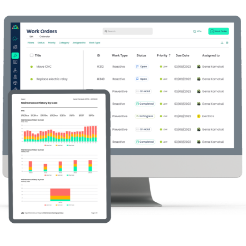
Explainable AI in CMMS: How to Build Trust with Maintenance Teams
Last winter, a maintenance technician at a U.S. paper mill ignored a predictive alert that flagged an imminent gearbox failure. Two days later, the machine malfunctioned, resulting in a $120,000 loss in production. When asked why the technician didn’t act, he replied, “I didn’t trust the system—it never told me why it thought something was wrong.”
This story highlights a growing issue in modern maintenance: technology can predict failures, but humans must have sufficient confidence in it to take action. That belief—the bridge between insight and action—is built on trust.
Thanks to ever-increasing investments in Artificial Intelligence, AI has rapidly found its way into maintenance management. AI is powering predictive maintenance alerts, optimizing work schedules, and automatically identifying long-term hidden failure patterns with zero human intervention. Modern CMMS Software also incorporates AI into its solutions. Yet, as powerful as these tools are, one crucial question remains: Can technicians and maintenance leaders trust AI’s recommendations and insights?
Do we humans have any other choice but to trust AI? How long can we hold on to our reservations about AI?
The answer lies in an emerging and growing concept known as Explainable AI (XAI). Explainable AI is a movement aimed at making machine learning systems transparent, interpretable, and accountable. In the context of CMMS, explainability might be the key to XAI adoption.

Trust Deficit in AI-Driven Maintenance
AI-driven maintenance promises fewer breakdowns, optimized resources, and data-driven insights. However, if technicians don’t understand why a CMMS recommends a part replacement or predicts a failure, they often ignore or override it. This gap between prediction and human trust is one of the biggest challenges in modern maintenance transformation. Maintenance management needs to address this trust deficit before fully adopting Artificial Intelligence into its maintenance processes and workflow.
For decades, maintenance teams have relied on intuition, experience, and the “feel” of equipment to make decisions. CMMS software came into play to enable decision-making by serving as a central repository for all maintenance tasks. But when an AI-powered CMMS suddenly begins suggesting actions based on algorithmic predictions, skepticism is natural. Naturally, maintenance technicians may feel that their bastion of decision-making is being encroached upon by AI.
The barriers may appear cultural, but they are at the heart of how we humans tend to behave when confronted with change.
- Technicians with years of practical experience who view AI as “theory.”
- Fear that automation could replace human judgment.
- Mistrust of black-box systems that can’t explain their rationale.
Explainable AI bridges this divide. It doesn’t replace intuition—it supports it with data-backed insights that are understandable and auditable. When AI’s reasoning aligns with technician experience, trust follows naturally.
What Explainable AI Means in the Context of CMMS
The Click Maint blog has discussed in detail how Artificial Intelligence (AI) is transforming how organizations use the CMMS platform. Not just automation use cases, AI is transforming CMMS software from passive data repositories into intelligent decision engines. Thus, redefining how maintenance teams anticipate, act, and optimize their work. The AI CMMS impact areas are as follows:
- Predictive and Condition-Based Maintenance
- Real-Time Visibility and Remote Operations
- Smarter Resource Allocation
- Data-Driven Decision-Making
AI is increasingly making its presence felt in areas where complex decision-making is involved. This area requires an additional XAI layer.
In a CMMS environment, Explainable AI (XAI) refers to AI algorithms that can:
- Clarify the reasoning behind each maintenance recommendation.
- Show the data sources or sensor readings that influenced the decision.
- Display confidence levels (e.g., 85% probability of failure within 48 hours).
- Provide traceability—a way to audit historical predictions versus outcomes.
This transparency transforms AI from a black box into a trusted partner. When technicians can see why a CMMS predicts a failure, they can validate the logic using their experience and expertise.
Explainable AI CMMS Building Blocks
The explainable AI CMMS building blocks follow the principle of “Show and Tell.”
Instead of just telling what maintenance technicians do, explainable AI CMMS goes a step further by substantiating its recommendations with supporting data and explanation. In addition to leveraging data, explainable AI CMMS also builds on past insights and decisions.
Here are some of the building blocks:
Feature Attribution and Transparency Dashboards
Team dashboards are the lowest-hanging fruit for building alignment between man and machine. Modern CMMS platforms can utilize AI models that highlight which factors most significantly influenced a prediction—such as temperature spikes, vibration anomalies, or past repairs.
Presenting all the above information visually (via dashboards or color-coded indicators) enables users to grasp the cause-and-effect relationship instantly. Seeing is believing, after all.
Probability %
A corresponding probability score should accompany every prediction. For example: “This compressor has an 87% chance of bearing failure within seven days.” The probability score adds realism to the shop floor context. Teams can calibrate urgency and assess whether preventive action is justified.
Human-in-the-Loop Validation
Genuine trust requires collaboration between AI and human expertise. CMMS workflows should allow technicians to confirm, reject, or annotate AI-generated alerts. Over time, these human-in-the-loop corrections help retrain the AI model for greater accuracy, adding a layer of technician tribal knowledge.
Explainability Reports
Each predictive alert should be accompanied by an audit trail that includes data trends, model inputs, and rationale, making it easy to explain maintenance decisions during reviews or audits. This detailed reporting earns technicians' trust and supports compliance requirements.
Explainable AI CMMS - Implementation Challenges and Steps
The challenges are similar to those faced during a CMMS implementation, with a few more.
Explainable AI Challenges
While explainability is critical, implementation isn’t simple. Common challenges include:
- Ambiguous scope: At the start, the XAI scope needs to prioritize the areas that can actually benefit from Explainable AI. There is a tendency to look at Explainable AI as a site-wide implementation.
- Legacy systems: Older CMMS platforms were not mainly designed for AI integration.
- Data silos: Inconsistent sensor data or missing context reduces transparency. Data quality continues to be a common theme for all technology implementations.
- User experience (UX) complexity: Too much technical detail can overwhelm non-data specialists.
- Resource constraints: Building or maintaining XAI features requires specialized skills and commitment to increasing budgets.
To overcome these challenges, organizations should start small—pilot XAI on one or two asset classes, design intuitive dashboards, and prioritize clear communication over algorithmic depth. As in any CMMS system implementation, it is vital to focus on “fast quick wins.” Here is how teams can maximize their chances of success.
Implementation Steps
When your team is implementing Explainable AI, most will already have been part of a successful CMMS implementation. At this stage, the simplest option would be to revisit the CMMS implementation playbook. Here are some steps to consider.
- Start with Transparency Goals: Define what level of explainability your team needs (simple confidence scores vs. complete feature visualization). Additionally, look at which maintenance areas can serve as the best use cases and prioritize them.
- Choose CMMS Platforms with XAI Capabilities: Look for solutions that prioritize interpretability—those that can visualize reasoning rather than just produce outputs. This would be the best option for a greenfield CMMS AI implementation. In the event of a brownfield implementation, where the existing CMMS software is layered with Explainable AI.
- Train Maintenance Teams Early: Incorporate “AI literacy” training sessions to show how the system makes predictions. Consumer AI applications like ChatGPT have made this step easy by making users familiar and comfortable with AI.
- Integrate Human Feedback Loops: The CMMS Software should allow technicians to verify and annotate AI insights. This is a must for building the trust loop as well.
- Audit and Report: Regularly evaluate prediction accuracy, false alarms, and technician feedback to improve both trust and performance.
In the end, humans win.
Explainable AI doesn’t just improve prediction accuracy—it changes the culture of maintenance. When technicians understand why the system recommends an action, they’re far more likely to trust, use, and even advocate for it. The result? The three main challenges of maintenance management - downtime, labor productivity, and spare parts inventory management - are addressed with confidence. On top of that, a CMMS becomes the backbone of reliability.
As maintenance evolves from reactive to predictive—and now to prescriptive—explainability is what keeps AI human-centered. In the end, it’s not just about smarter algorithms; it’s about more innovative teams who trust them.
At its heart, maintenance is a human craft. AI and CMMS systems are tools that extend expertise, not replace it. By focusing on transparency, collaboration, and continuous learning, maintenance organizations can build a future where human intuition and artificial intelligence work in harmony—creating workplaces that are not only efficient but also deeply trusted.
TABLE OF CONTENTS
Keep Reading
Every maintenance professional faces it sooner or later — that critical time when an aging ...
18 Nov 2025
The term 'best' is often used loosely, without a clear understanding of its context or ...
14 Nov 2025
In the not too distant past, maintenance strategies have been defined by reaction—fixing ...
13 Nov 2025
Tax season is the time of year that often sends a ripple of anxiety through many of us. The ...
11 Nov 2025
Selecting a Computerized Maintenance Management System (CMMS) can, at first glance, be an ...
4 Nov 2025
In healthcare facilities, equipment uptime involves more than achieving operational ...
31 Oct 2025
Companies are subject to economic ups and downs, also known as economic volatility. Today, ...
30 Oct 2025
Maintenance challenges are a constant struggle, with unplanned downtime costing manufacturers ...
27 Oct 2025
Many organizations proudly say they “have a CMMS,” but ownership alone doesn’t equal ...
9 Oct 2025
Every maintenance team is under pressure to do more with less. Unplanned downtime is often ...
7 Oct 2025
The implementation of simple, yet powerfully effective, checklists has repeatedly ...
3 Oct 2025
In manufacturing, every second counts. When production stops, whether due to scheduled ...
2 Oct 2025
The increasing cost of maintenance, lack of accountability, and siloed systems leave many ...
30 Sep 2025
Preventive maintenance is one of those things maintenance teams know they need to do, but it ...
26 Sep 2025
Public services are essential to daily life. The provision of safe roads, functional transit, ...
25 Sep 2025
For most manufacturing facilities, a major focus of their maintenance teams revolves around ...
24 Sep 2025
Have you ever tried explaining to the CEO why the production line has been down for hours ...
18 Sep 2025
Over the past few decades, the hotel industry has undergone a dramatic transformation. ...
16 Sep 2025
Profitability is at the top of the list for manufacturing organizations when conversations ...
12 Sep 2025
Lean manufacturing is a goal that organizations strive for in their quest for operational ...
11 Sep 2025






